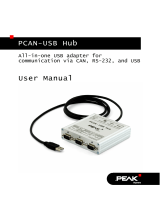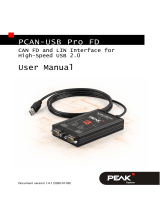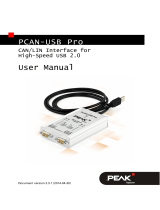Page is loading ...

PCAN-USB Hub
All-in-one USB adapter for
communication via CAN, RS-232, and USB
User Manual
V2.1.1

PCAN-USB Hub – User Manual
2
Products taken into account
Product Name Model Part Number
PCAN-USB Hub IPEH-002004
CANopen® and CiA® are registered community trade marks of CAN in Automation
e.V.
All other product names mentioned in this document may be the trademarks or
registered trademarks of their respective companies. They are not explicitly marked
by “™” and “®”.
© 2012 PEAK-System Technik GmbH
PEAK-System Technik GmbH
Otto-Roehm-Strasse 69
64293 Darmstadt
Germany
Phone: +49 (0)6151 8173-20
Fax: +49 (0)6151 8173-29
www.peak-system.com
info@peak-system.com
Documen
t version 2.1.1 (2012-04-04)

PCAN-USB Hub – User Manual
3
Contents
1 Introduction 5
1.1 Properties at a Glance 5
1.2 System Requirements 6
1.3 Scope of Supply 7
2 Installing the Software and the Adapter 8
3 Connectors on the Adapter 11
3.1 Upstream Port (USB Cable) 11
3.2 Power (Voltage Supply) 11
3.3 CAN 12
3.3.1 Supplying External Devices via the CAN
Connector 13
3.4 RS-232 15
3.5 USB Ports (Downstream) 15
3.6 Cabling 16
3.6.1 Termination 16
3.6.2 Example of a Connection 16
3.6.3 Maximum Bus Length 17
4 Operation 18
4.1 Status LEDs 18
4.2 Unplugging the Hub 19
4.3 Distinguishing Several PCAN-USB Hub 19
5 Using the Software 20
5.1 CAN Monitor PCAN-View for Windows 20
5.1.1 Receive/Transmit Tab 22
5.1.2 Trace Tab 24
5.1.3 PCAN-USB Tab 25

PCAN-USB Hub – User Manual
4
5.1.4 Status Bar 25
5.2 Linking Own Programs with PCAN-Basic 26
5.2.1 Features of PCAN-Basic 27
5.2.2 Principle Description of the API 28
5.2.3 Notes about the License 29
6 Technical Specifications 30
Appendix A CE Certificate 32
Appendix B Dimension Drawing 33
Appendix C Quick Reference 34

PCAN-USB Hub – User Manual
5
1 Introduction
The PCAN-USB Hub provides several hardware interfaces via a USB
connection. The device has connection facilities for one CAN bus,
two serial RS-232 connections, and two additional USB devices.
Device drivers and programming interfaces exist for different
operating systems, so programs can easily access a connected CAN
bus.
Tip: At the end of this manual (Appendix C) you can find a
Quick Reference with brief information about the installation
and operation of the PCAN-USB Hub.
1.1 Properties at a Glance
High-speed USB 2.0 hub with
• USB to CAN interface, connection through 9-pin D-Sub
(in accordance with CiA® 102)
• Two USB to RS-232 converters using two
D-Sub connectors (9-pin)
• Two High-speed USB 2.0 downstream ports
Passive (bus-powered) hub operation through the USB port of a
PC enables power consumption of up to 100 mA per USB
channel
Active (self-powered) hub operation through the optional
external hub power supply (9 - 36 V) enables power
consumption of up to 500 mA per USB channel
Guaranteed high transfer rates on all channels if a Full-speed
device is connected, thanks to a hub controller with 4
transaction translators

PCAN-USB Hub – User Manual
6
Bit rates up to 1 Mbit/s
Time stamp resolution approx. 42 μs
Compliant with CAN specifications 2.0A and 2.0B
NXP PCA82C251 CAN transceiver
5-Volt and external power supply at the CAN connector
connectible by solder bridges, e.g. for external bus converter
Extended operating temperature range from -40 to 85 °C
(-40 to 185 °F)
Note: This manual describes the use of the PCAN-USB Hub
with Windows. You can find CAN drivers for Linux and the
corresponding application information on the provided CD in
the directory branch Develop and on our website under
www.peak-system.com/linux.
1.2 System Requirements
A vacant USB port at the computer (USB 2.0 recommended)
Operating system Windows 7/Vista/XP (32/64-bit)
or Windows CE 6.x (x86 and ARMv4 processor support)
or Linux (32/64-bit)
Note: Do not use a USB extension cable to connect the PCAN-
USB Hub to the computer. The use of an extension cable does
not comply with the USB specification and can lead to
malfunction of the adapter.

PCAN-USB Hub – User Manual
7
1.3 Scope of Supply
PCAN-USB Hub in aluminum casing
Mating connector for voltage supply
Device drivers for Windows 7/Vista/XP (32/64-bit)
and Linux (32/64-bit)
Device driver for Windows CE 6.x
(x86 and ARMv4 processor support)
PCAN-View CAN monitor for Windows
PCAN-Basic programming interface consisting of an interface
DLL, examples, and header files for all common programming
languages
Manual in PDF format

PCAN-USB Hub – User Manual
8
2 Installing the Software and
the Adapter
This chapter covers the software setup for the PCAN-USB Hub
under Windows and the connection of the hub to the computer.
Drivers for the CAN interface as well as the RS-232 interfaces are
installed.
Setup the driver for the CAN interface before
connecting the PCAN-
USB Hub to the computer for the first time.
Do the following to install the driver for the CAN interface:
1. Windows XP only: Make sure that you are logged in as user
with administrator privileges (not needed for normal use of
the PCAN-USB Hub later on).
2. Insert the supplied CD into the appropriate drive of the
computer. Usually a navigation program appears a few
moments later. If not, start the file Intro.exe from the root
directory of the CD.
3. On the page English > Drivers activate the entry PCAN-USB.
4. Click on Install now. The setup program for the driver is
executed.
5. Follow the instructions of the setup program.
Tip: If you don't want to install the CAN monitor PCAN-View for
Windows onto hard disk together with the driver, you have the
option to start the program later directly from CD without prior
installation.

PCAN-USB Hub – User Manual
9
Do the following to connect the PCAN-USB Hub and carry out
the initialization of the CAN driver and the installation of the
drivers for the RS-232 interfaces:
Note: Do not use a USB extension cable to connect the PCAN-
USB Hub to the computer. The use of an extension cable does
not comply with the USB specification and can lead to
malfunction of the adapter.
1. Connect the PCAN-USB Hub to a USB port at the computer.
The computer can remain powered on.
Windows notifies that new hardware has been detected.
2. Windows XP only: A Wizard dialog box appears. Follow its
instructions. Deny the search for driver software at
Windows Update and select the automatic software
installation during this procedure.
3. Dialog boxes appear for the installation of the drivers for the
RS-232 interfaces (devices “USB <-> Serial Cable” and “USB
Serial Port”). Follow their instructions. Select the search for
driver software on CD during this procedure.
All Windows operating systems: The drivers are found and
installed by Windows.
4. Afterwards you can work as user with restricted rights
again.
After the initialization process for the driver for the CAN interface is
finished successfully the red LED at the CAN connector of the
PCAN-USB Hub is illuminated.

PCAN-USB Hub – User Manual
10
The Device Manager of Windows contains the following new
entries:
Ports (COM & LPT) > USB Serial Port (COMn
1
) and USB Serial
Port (COMn
1
)
CAN-USB-Hardware > PCAN-USB Device
Universal Serial Bus controllers > Generic USB Hub
Universal Serial Bus controllers > USB Serial Converter A
Universal Serial Bus controllers > USB Serial Converter A
Universal Serial Bus controllers > USB Composite Device
1
The port numbers for the COM ports may vary. If a COM port is occupied, the next
vacant port number is used. Changing the port number in the Device Manager:
Ports (COM & LPT) > USB Serial Port (COMn) > Properties > Port Settings >
Advanced

PCAN-USB Hub – User Manual
11
3 Connectors on the Adapter
3.1 Upstream Port (USB Cable)
The cable with the USB plug is used for connecting the PCAN-USB
Hub to a computer.
When a High-speed USB connection (USB 2.0) is established, the
LED at the upstream port is on. For a Full-speed USB connection
(USB 1.1) the LED stays off.
The upstream port can be used for voltage supply of the PCAN-USB
Hub (see the following section 3.2).
3.2 Power (Voltage Supply)
The voltage supply of the PCAN-USB Hub may either be done via
the upstream port or with an external power supply at the power
socket.
For voltage supply via Property
upstream port power socket
Supply voltage 5 V DC (USB) 9 - 36 V DC
Operating mode name Bus-powered Self-powered
Permissible current delivery
USB port 1/2
100 mA 500 mA
Permissible total current consumption
of hub (incl. additional USB devices at
the hub)
500 mA
If the permissible current delivery value is exceeded by connecting
additional USB devices to the PCAN-USB Hub, Windows shows a
respective warning and deactivates the related components.

PCAN-USB Hub – User Manual
12
Figure 1: Power socket at the rear of the PCAN-USB Hub
for the external voltage supply (self-powered operation)
The connection of an external power supply at the power socket is
done with the supplied mating connector for fastening cable
strands.
3.3 CAN
A High-speed CAN bus (ISO 11898-2) is connected to the 9-pin
D-Sub connector. The pin assignment for CAN corresponds to the
specification CiA® 102.
Figure 2: Pin assignment High-speed CAN
(view onto connector of the PCAN-USB Hub)
With the pins 1 and 9 devices with low power consumption (e.g. bus
converters) can be directly supplied via the CAN connector. At
delivery these pins are not assigned. You can find a detailed
description about the activation in the following section 3.3.1.
Tip: You can connect a CAN bus with a different transmission
standard via a bus converter. PEAK-System offers different bus
converter modules (e.g. PCAN-TJA1054 for a Low-speed CAN
bus according to ISO 11898-3).

PCAN-USB Hub – User Manual
13
3.3.1 Supplying External Devices via the CAN
Connector
By setting solder bridges on the PCB of the PCAN-USB Hub (casing
opened) a 5-Volt supply can be routed to pin 1 and the external
voltage supply, if available, can be routed to pin 9 of the D-Sub CAN
connector.
CAN D-Sub pin Voltage Max. current delivery
1 +5 V 100 mA
9 external supply voltage
(9 - 36 V)
2 A
If the solder bridge for pin 9 is set, the state of this pin can be
switched by software (on/off). At delivery pin 9 is on referred to the
software part. On request we’ll provide you with additional informa-
tion and a Windows program for switching (contact information:
see on page 2
Proceed as follows to activate the 5-V
olt supply and the external
voltage supply at the CAN connector:
Attention! Electrostatic discharge (ESD) can damage or destroy
components on the PCAN-USB Hub board. Take precautions to
avoid ESD when handling the card.
Remove the four lower corner screws from the aluminum casing of
the PCAN-USB Hub and then the bottom cover.
Set the solder bridge(s) on the PCB of the PCAN-USB Hub according
to the desired function. During this procedure take especially care
not to produce unwanted short circuits on the board.
The following figure shows the positions of the solder fields on the
PCB of the PCAN-USB Hub; the tables below contain the possible
settings.

PCAN-USB Hub – User Manual
14
Figure 3: Positions of the solder fields JP103 and JP104
on the PCB of the PCAN-USB Hub
5-Volt supply →
None Pin 1
JP104
External supply →
None Pin 9
JP103
Attention! Risk of short circuit! If the option described in this
section is activated, you may only connect or disconnect CAN
cables or peripheral systems (e.g. external bus converters) to or
from the PCAN-USB Hub while it is de-energized (the hub is not
connected to the computer). Consider that some computers still
supply the USB ports with power even when they are turned off
(standby operation).

PCAN-USB Hub – User Manual
15
3.4 RS-232
An RS-232 connection is done via a 9-pin D-Sub connector.
Figure 4: Pin assignment RS-232 A/B
(view onto connector of the PCAN-USB Hub)
3.5 USB Ports (Downstream)
Further USB devices can be connected to the USB ports 1 and 2.
Figure 5: USB ports at the back of the PCAN-USB Hub
When using the USB ports, we recommend the voltage supply of
the PCAN-USB Hub via the power socket (self-powered operation).
See also section 3.2
Power (Voltage Supply)
on page 11.
Supply via Operating mode Current delivery USB port 1/2
Upstream port Bus-powered max. 100 mA
Power socket Self-powered max. 500 mA

PCAN-USB Hub – User Manual
16
3.6 Cabling
3.6.1 Termination
A High-speed CAN bus (ISO 11898-2) must be terminated on both
ends with 120 Ohms. Otherwise, there are interfering signal
reflections and the transceivers of the connected CAN nodes (CAN
interface, control device) will not work.
The PCAN-USB Hub does not have an internal termination. Use the
adapter on a terminated CAN bus.
3.6.2 Example of a Connection
Figure 6: Simple CAN connection
In this example, the PCAN-USB Hub is connected with a control unit
by a cable that is terminated at both ends.

PCAN-USB Hub – User Manual
17
3.6.3 Maximum Bus Length
High-speed CAN networks may have bit rates of up to 1 Mbit/s,
where all CAN nodes must be able to process messages
simultaneously. The maximum bus length depends primarily on the
bit rate.
The following table shows the maximum possible CAN bus length
at different bit rates:
Bit rate Bus length
1 Mbit/s 40 m
500 kbit/s 110 m
250 kbit/s 240 m
125 kbit/s 500 m
50 kbit/s 1,3 km
20 kbit/s 3,3 km
10 kbit/s 6,6 km
5 kbit/s 13,0 km
The listed values have been calculated on the basis of an idealized
system and can differ from reality.

PCAN-USB Hub – User Manual
18
4 Operation
4.1 Status LEDs
The PCAN-USB Hub has several status LEDs.
Figure 7: Arrangement of the LEDs on the back side,
USB upstream / power socket
Power
LED Status Meaning
Green on Supply via upstream port Power
Red on external voltage supply
LED Status Meaning
Red on High-speed USB connection (USB 2.0) with a
computer
USB upstream
OFF Full-speed USB connection (USB 1.1) with a
computer

PCAN-USB Hub – User Manual
19
Figure 8: Arrangement of the LEDs on the front side,
CAN / RS-232 A/B
LED Status Meaning
Red on The CAN interface is initialized. There's a
connection to a driver of the operating
system
Red slow blinking A software application is connected to the
CAN interface
CAN
Red quick blinking Data is transmitted via the connected CAN
bus
RS-232 A/B Green quick blinking Transmission on TxD or RxD
4.2 Unplugging the Hub
Under Windows the icon for removing hardware safely is not used
with the PCAN-USB Hub. You can unplug the adapter from the
computer without any preparation.
4.3 Distinguishing Several PCAN-USB Hub
You can operate several PCAN-USB Hub adapters on a single
computer at the same time. The supplied program PCAN-View
allows the assignment of device IDs in order to distinguish the
adapters in a software environment. Fore more information see
section 5.1.3 on page 25.

PCAN-USB Hub – User Manual
20
5 Using the Software
This chapter covers the provided software PCAN-View and the
programming interface PCAN-Basic.
5.1 CAN Monitor PCAN-View for Windows
PCAN-View for Windows is a simple CAN monitor for viewing
transmitting, and logging CAN messages.
Figure 9: PCAN-View for Windows
Do the following to start and initialize PCAN-View:
1. If PCAN-View is already installed on the hard disk, open the
Windows Start menu, go to Programs > PCAN-Hardware,
and select the entry PCAN-View.
/





